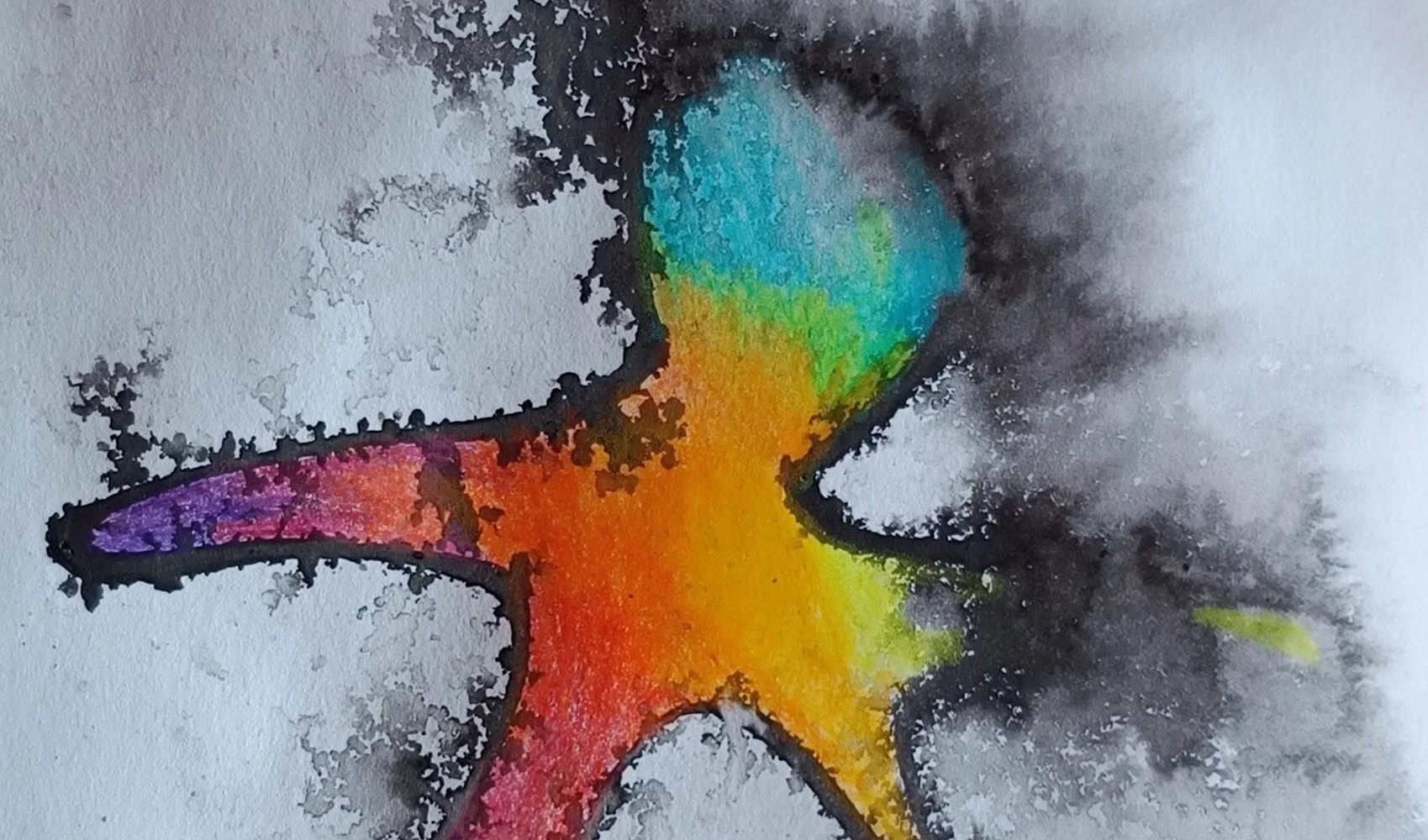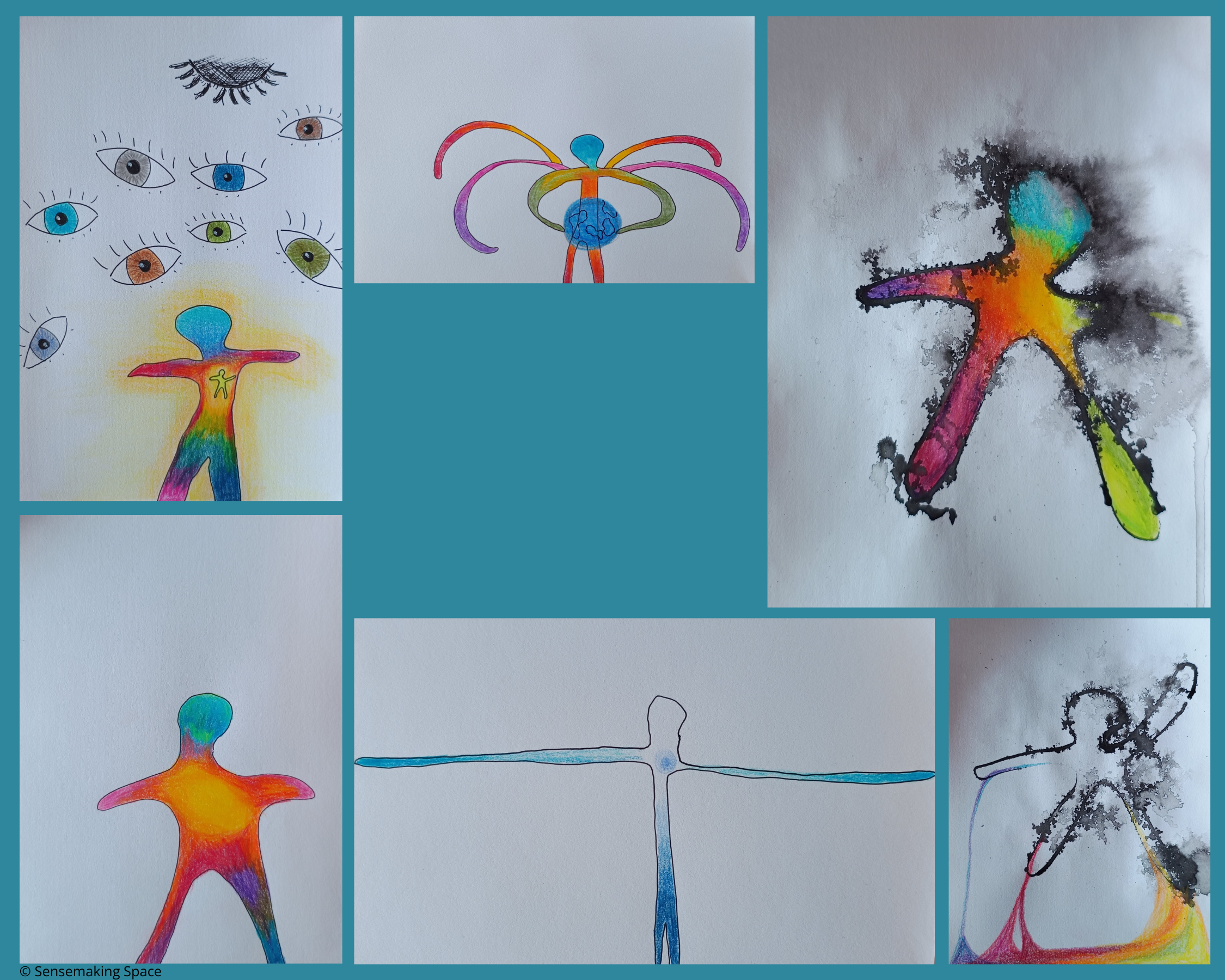A glimpse into arts-based coaching: working in series
Arts-based coaching comes in many forms, shapes and colours. It’s always steered by the person who is exploring their experience: their preferences of materials, modalities, colour schemes, formats etc. will shape the arts-based process and exploration.
During a recent personal inquiry, I felt drawn to creating a series of simple sketches. The process was quick, easy and very insightful.
It made me reflect on how creating a series can support the meaning making process.
What do I mean by working in a series?
With a series, you end up with a number of representations that were all created around a certain experience, and each one highlights a distinct aspect of this experience or a shade or flavour of this experience. Simultaneously, all representations are connected and form a small body of work.
When working in series, you pick a consistent shape, size or a small set of materials. In my case I went for consistent shape: each sketch was a gingerbread man.
This is the complete series I created during my inquiry.
Placing a restriction on your creative process is an important (and beneficial!) step when working in a series.
You replace the complete freedom of creating anything with some guardrails to create something more defined. In my case, the restrictions were:
I used the same A5 sketchpad for all sketches;
My set of materials was reduced: black ink, black marker, colour pencils;
At the heart of all sketches was the same shape, a ‘gingerbread man’.
Restrictions can be your friend in the creative process. They help you get started. And they keep you moving when you feel stuck, want to procrastinate or get lost in too many ideas.
Artists and anyone working creatively know this:
“Give me the freedom of a tight brief.”
Once I had restricted myself to the gingerbread man, all I needed to wonder was: where on the piece of paper should it be? Is it thin and spindly, or square and sturdy? Where are the arms, how many arms…? What’s its stance? Sharp outline or do I get the spray bottle and douse it in water?
Once you’ve chosen your consistent shape or motif, you experiment with changing one element: you play with size, composition, colour, materials... You simply wonder: what would the gingerbread man look like in this situation? And how would I draw it when my experience changes into this other situation or experience?
Working in series also supports a cyclical inquiry.
It allows me to return to earlier sketches and make changes as I generate insights about my inquiry topic during the process of making.
It’s possible that a sketch feels unfinished, but I don’t know how to make it feel more complete. Rather than getting stuck here I simply move to the next sketch. Often, as I keep working on other sketches, it suddenly becomes clear what I need to do with my ‘stuck sketch’ to capture my experience with accuracy.
Generating insight can be easier when a common theme or shape provides the thread that holds your artworks together.
Creating a series as part of your exploration supports a ‘compare and contrast’ inquiry.
Imagine I had tried to create six completely different sketches, still with the intention that they’re all linked to a similar experience. It would have been much harder to come up with six, totally unrelated ideas that also represent different shades or flavours of my experience.
Let’s assume I had managed that and sketched a gingerbread man, a river, a mountain landscape, a car, a skyscraper and an elephant… this needs decidedly more drawing skills and time than six gingerbread men! Even if I had managed to do that, making sense of the six sketches and how they represent my experience would have been much trickier.
When I notice that in some sketches the gingerbread man is floating and in others it’s standing on the ground, it’s easier to make sense of that then figuring out why my experience in this moment resembles an elephant, and in the next moment it’s more akin to a car.
Each sketch itself was done in a couple of minutes; the colouring in might take a bit longer and during this almost meditative process I had time to reflect on this sketch a bit more and get curious about my placement of the gingerbread man and its exact shape. Of course, the colours hold meaning as well.
Not all six sketches were done in one sitting. It’s ok to break up the process and allow yourself to ponder and be curious whether the process stirs up any other images, memories, or responses in you.
How can you experiment with working in a series to support your reflections?
(1) Decide on a limited set of materials.
(2) Choose a ‘suitable’ shape.
You should feel that you can draw it quite easily. The ‘gingerbread man’ outline doesn’t require advanced drawing skills. It’s not intended to look like a real person. It doesn’t need facial features to work, but I could have added some if that had been useful to my inquiry.
It should also be a shape that you can vary playfully. If you want to pick a shape that’s not that variable, you can, of course, also vary the materials you use to create each shape in your series.
I had a balance of enough simplicity to make creating the series easy and enough stuff I could play with and vary to represent my changing experience: does the gingerbread man look solid or is it thin and stretched? Is it grounded or floating? Is the outline solid or did I spray the ink outline with water to create a porous, blurred gingerbread man? Is there colour? What’s the colour scheme? How did I apply colour, lightly or opaque? Are there additional elements, like the eyes in one sketch?
(3) Remember that there’s a cutting floor.
When I work in a series, I can quickly create a number of representations and then pick the ones that capture my experience most accurately. Trust that you’ll know intuitively which ones feel right and represent what’s true for you. Not every sketch has to stay in the series that you reflect on at the end of your meaning making process. You can always choose to have a cutting floor.
As an aside, be curious, at least for a hot minute, what you discard on the cutting floor.
(4) Your final reflections
Once the series feels complete, look for similarities and differences. Be curious about which sketches you like more than others. Which ones surprise you. Which do you find intriguing. What does each sketch stir in you? Does it bring up thoughts, emotions, memories, physical sensations, other imagery?
This is just one example of the type of processes we explore in Sensemaking Studio in more depth.
All Sensemaking Studio programs have an arts-based element. The 4-month program Creative Reflections is the group where we focus most on arts-based reflections. It’s a foundation program where you’ll get familiar with some core processes.
After that you can join our monthly community of practice to keep experimenting and deepening your skills around tapping into your creative parts to reflect and learn.
Sign up to my newsletter to be notified when the next group program will start.
If you want to explore arts-based coaching in a 1-on-1 setting, book a free Discovery Call or find out more here.
An example of an arts-based reflective inquiry created during one of my monthly Studio Sessions.


